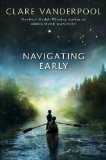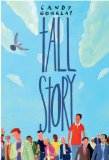Summary | Excerpt | Reviews | Beyond the book | Read-Alikes | Genres & Themes | Author Bio

Middle-grade readers are in luck. Levine has written a
richly-realized tale of a powerful best-friendship and a boy's passage into
manhood during a shameful and violent period in America's past.
Moundville Alabama is the backdrop for twelve-year-old Dit
Sims' lively (occasionally hokey) first-person narrative. One of ten children of
a white family, Dit's days are filled with hunting, fishing, chopping wood, skipping stones
along the surface of the Black Warrior River, and lessons in a one-room school.
Rural life during the teens of the last century will absorb and shock young
twenty-first century readers: Levine confidently and convincingly describes
Dit's once-weekly baths in a washtub; his hand-wound twine baseball; his games
of marbles; his first disorienting and overwhelming experience watching a silent
movie; and the racial divisions, bigotry, hypocrisy and violence that inform
small-town civilities in early 20th century Alabama. There is a school for
whites and a school for blacks, a white church and a black
church. African American men relinquish their seats to white men during evening
gatherings in front of the town general store. White men steal from African
American men without punishment, everyone (at least it appears this way) mourns
the South's loss of the Civil War.
It is only when African-American Emma Walker becomes his
neighbor that Dit begins to question the way things are and have always been.
Emma and her parents are educated, refined and proud Bostonians. Mr. Walker is
the town's postmaster and Mrs. Walker is a skilled nurse. Emma is a lonely and
intellectual girl who is ignorant of or indifferent to the things that matter
most to Dit. Levine might have been more effective if country Dit and city Emma
had been more nuanced characters, less symmetrical in their contrasts. Having
read a book or two would not have blunted Dit's energy, and Emma's sensitivity
wouldn't have been dulled by having thrown a ball or jumped rope. Instead,
Levine's Emma is Yin to Dit's Yang, formal and thoroughly literary while Dit is an unread (and unwashed most days) hick. Emma is
introspective, wary, and observant while Dit is thoughtless and impulsive -
often speaking without thinking.
One of the most interesting conflicts between the two friends
concerns killing. Dit has a great arm which he uses to stone birds to death for fun. He is
eager to enter a 4th of July hunting contest, and thinks nothing of
trapping rabbits in painful snares. Emma's thoughtful objections to Dit's cruel
wounding of a buzzard force Dit to distinguish between hunting and killing and
to recognize animals' capacity for suffering. Emma comes to accept hunting for
food and strives to respect hunting simply because it is important to her
friend. The give and take between the two youngsters softens Dit's hard edges
and eventually sensitizes him to the human anguish in his world. He winces when the
town bully and sheriff, Big Foot, insults Emma or humiliates her father or the
other African American men in the town.
Levine is most effective when she presents history without
commentary or too much drama. When the children discover a native American bowl
in a cave; or when they spend a thrilling night in the cabin of a local hermit during a rainstorm; or when an airplane, low on fuel, touches
down in a cow pasture near town, Levine succeeds in transporting the reader to
Alabama in 1917. But when Dit and Emma witness the killing of the town sheriff by an African American
who does so in self defense but is nonetheless convicted of murder, and they devise a plot to free him
from jail, improbability and complexity dampen the
adventure. Dit and Emma are liveliest and most real and
wonderful when the novel's ambitions weigh most lightly upon them: When the
youngsters build a secret hideout, stock it with soda, and share it daily after
school; when Dit teaches Emma to skip stones, or to throw a baseball while Emma
helps him memorize state capitols.
'Show me again,' said Emma.
So I took her hand in mine and wrapped it around a smooth flat stone. Her
fingers were cool and stiff, but her skin was beautiful, kind of like the mud in
the creek after a hard rain. I rubbed her hands between mine, trying to get the
blood running. She watched me. Then I said, 'Try it again.'
She took that stone and threw it so hard, it skipped seven or
eight times across the water. We both stood there with our mouths open. I'm not
sure who was more surprised.
In discovering each other, the two friends discover themselves.
![]() This review was originally published in The BookBrowse Review in March 2009, and has been updated for the
October 2010 edition.
Click here to go to this issue.
This review was originally published in The BookBrowse Review in March 2009, and has been updated for the
October 2010 edition.
Click here to go to this issue.

If you liked The Best Bad Luck I Ever Had, try these:

by Clare Vanderpool
Published 2014
New York Times Best Seller Navigating Early by Clare Vanderpool, Newbery Medalist for Moon Over Manifest, is an odyssey-like adventure of two boys' incredible quest on the Appalachian Trail where they deal with pirates, buried secrets, and extraordinary encounters.

by Candy Gourlay
Published 2012
In a novel packed with quirkiness and humor, Gourlay explores a touching sibling relationship and the clash of two very different cultures.
Your guide toexceptional books
BookBrowse seeks out and recommends the best in contemporary fiction and nonfiction—books that not only engage and entertain but also deepen our understanding of ourselves and the world around us.